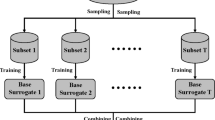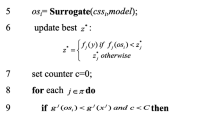Abstract
When the surrogate-assisted evolutionary algorithm is used to solve expensive many-objective optimization problems, the surrogate is used to approximate the expensive fitness functions. However, with the increase of the number of objectives, the approximate error of the surrogate will accumulate gradually, and the computational cost will also increase sharply. This paper proposes an improved bagging ensemble surrogate-assisted evolutionary algorithm (IBE-CSEA) to solve these problems. An ensemble classifier is used to classify the offspring instead of building the surrogate to approximate the fitness function of each objective. Firstly, a group of classification boundary individuals are selected one by one from the individuals evaluated by the expensive fitness function. All the individuals evaluated by the expensive fitness function are divided into two categories; Secondly, the individuals in these two categories are divided into the training set and the test set. The training set is used to train an improved bagging ensemble classifier. The test set is used to calculate the reliability of the classification; Finally, the classification results and the reliability are used to select the promising individuals for expensive fitness function evaluation. Compared with the current popular surrogate-assisted evolutionary algorithm, IBE-CSEA algorithm is more competitive.







Similar content being viewed by others
Explore related subjects
Discover the latest articles, news and stories from top researchers in related subjects.Data availability
The data used to support the findings of this study are available from the corresponding author upon request.
Abbreviations
- ANN:
-
Artificial Neural Network
- CPS-MOEA:
-
Classification and Pareto Domination based Multi-Objective Evolutionary Algorithm
- CSEA:
-
Classification-based Surrogate-Assisted Evolutionary Algorithm
- EA:
-
Evolutionary Algorithm
- FE:
-
Fitness Evaluation
- HV:
-
Hypervolume
- IBE-CSEA:
-
Improved Bagging Ensemble Surrogate-Assisted Evolutionary Algorithm
- IGD:
-
Inverse Generational Distance
- K-RVEA:
-
Surrogate-Assisted Reference Vector Guided Evolutionary Algorithm
- KTA2:
-
A Kriging-Assisted Two-Archive Evolutionary Algorithm
- MAE:
-
Mean Absolute Error
- MaOP:
-
Many-Objective Optimization Problem
- MOEA/D-EGO:
-
Expensive Multi-Objective Optimization by MOEA/D with Gaussian Process Model
- MOP:
-
Multi-Objective Optimization Problem
- NSGA-III:
-
Evolutionary Many-Objective Optimization Algorithm Using Reference-Point-Based Nondominated Sorting Approach
- PF:
-
Pareto Front
- RMSE:
-
Root Mean Squared Error
- SAEA:
-
Surrogate-Assisted Evolutionary Algorithm
- c :
-
Categories of solution.
- C Pi :
-
Model prediction results.
- d :
-
The number of the decision variables.
- d i :
-
Deviation between the predicted value and the true value.
- FE max :
-
Maximum number of evaluations.
- K :
-
The number of the classification boundary solutions.
- M :
-
The number of objectives.
- N :
-
Population size.
- P :
-
Population.
- p m :
-
Mutation probability.
- P R :
-
Classification boundary.
- Q :
-
offspring population.
- Q c :
-
The set of group c solutions.
- rr :
-
Proportion of group A solutions.
- S :
-
Training set.
- S’ :
-
Test set.
- T :
-
Model pool size.
- Ω :
-
Realized non-dominated solution set.
References
Deb K, Jain H (2014) An evolutionary many-objective optimization algorithm using reference-point-based nondominated sorting approach, part I: solving problems with box constraints. IEEE Trans Evol Comput 18:577–601
Zitzler E, Laumanns M, Thiele L (2001) SPEA2: improving the strength Pareto evolutionary algorithm. TIK-report, 103
Gu Q, Chen H, Chen L (2001) A many-objective evolutionary algorithm with reference points-based strengthened dominance relation[J]. Inf Sci 554:236–255
Jin Y (2011) Surrogate-assisted evolutionary computation: recent advances and future challenges. Swarm Evolution Comput 1:61–70
Zheng J (2018) An output mapping variable fidelity metamodeling approach based on nested Latin hypercube design for complex engineering design optimization. Appl Intell 48:3591–3611
Jin Y, Sendhoff B (2009) A systems approach to evolutionary multiobjective structural optimization and beyond. IEEE Comput Intell Mag 4:62–76
Douguet D (2010) E-LEA3D: a computational-aided drug design web server. Nucleic Acids Res 38:W615–W621
Gu L, Yang RJ, Tho CH (2001) Optimisation and robustness for crashworthiness of side impact[J]. Int J Veh Des 26:348–360
Gu Q, Wang Q, Li X (2021) A surrogate-assisted multi-objective particle swarm optimization of expensive constrained combinatorial optimization problems[J]. Knowl-Based Syst 223:107049
Wilson B, Cappelleri D, Simpson TW, Frecker M (2001) Efficient Pareto frontier exploration using surrogate approximations. Optim Eng 2:31–50
Knowles J (2006) ParEGO: a hybrid algorithm with on-line landscape approximation for expensive multiobjective optimization problems. IEEE Trans Evol Comput 10:50–66
Theil H (1992) A rank-invariant method of linear and polynomial regression analysis. In Henri Theil's contributions to economics and econometrics. Springer, Dordrecht, pp 345–381
Van Stein B, Wang H, Kowalczyk W (2020) Cluster-based kriging approximation algorithms for complexity reduction[J]. Appl Intell 50:778–791
Dreiseitl S, Ohno-Machado L (2002) Logistic regression and artificial neural network classification models: a methodology review. J Biomed Inform 35:352–359
Chugh T, Jin Y, Miettinen K (2018) A surrogate-assisted reference vector guided evolutionary algorithm for computationally expensive many-objective optimization[J]. IEEE Trans Evol Comput 22:129–142
Zhang J, Zhou A, Zhang G (2015) A classification and Pareto domination based multiobjective evolutionary algorithm. In 2015 IEEE congress on evolutionary computation (CEC), pp 2883–2890
Pan L, He C, Tian Y, Wang H, Zhang X, Jin Y (2018) A classification-based surrogate-assisted evolutionary algorithm for expensive many-objective optimization. IEEE Trans Evol Comput 23:74–88
Böhning D (1992) Multinomial logistic regression algorithm. Ann Inst Stat Math 44:197–200
Gu Q, Chang Y, Li X (2021) A novel F-SVM based on FOA for improving SVM performance[J]. Expert Syst Appl 165:113713
Peterson LE (2009) K-nearest neighbor. Scholarpedia 4:1883
Rokach L (2010) Ensemble-based classifiers. Artif Intell Rev 33:1–39
Seni G, Elder JF (2010) Ensemble methods in data mining: improving accuracy through combining predictions[J]. Synthesis Lectures Data Mining Knowl Discovery 2:1–126
Liu Y, Gong D, Sun J, Jin Y (2017) A many-objective evolutionary algorithm using a one-by-one selection strategy. IEEE Trans Cybern 47:2689–2702
Sschapire RE (1999) A brief introduction to boosting. In Ijcai, pp 1401–1406
Breiman L (1996) Bagging predictors. Mach Learn 24:123–140
Beasley D, Bull DR, Martin RR (1993) A sequential niche technique for multimodal function optimization. Evol Comput 1:101–125
Helton JC, Davis FJ (2003) Latin hypercube sampling and the propagation of uncertainty in analyses of complex systems. Reliab Eng Syst Safety 81:23–69
Zhou ZH, Wu J, Tang W (2002) Ensembling neural networks: many could be better than all[J]. Artif Intell 137(1–2):239–263
Dai Q, Yao CSA (2017) Hierarchical and parallel branch-and-bound ensemble selection algorithm[J]. Appl Intell 46:45–61
Polikar R (2012) Ensemble learning[M]. Ensemble macshine learning. Springer, Boston, MA 1-34
Zhang Y, Burer S, Nick Street W (2006) Ensemble Pruning Via Semi-definite Programming[J]. J Mach Learn Res 7(7)
Levinson N (1946) The wiener (root mean square) error criterion in filter design and prediction. J Math Phys 25:261–278
Deb K, Thiele L, Laumanns M, Zitzler E (2005) Scalable test problems for evolutionary multiobjective optimization. In Evolutionary multiobjective optimization, pp 105–145
Cheng R, Li M, Tian Y, Xiang X, Zhang X, Yang S (2018) Benchmark functions for the cec'2018 competition on many-objective optimization
While L, Hingston P, Barone L, Huband S (2006) A faster algorithm for calculating hypervolume. IEEE Trans Evol Comput 10:29–38
Zhang Q, Liu W, Tsang E, Virginas B (2009) Expensive multiobjective optimization by MOEA/D with Gaussian process model. IEEE Trans Evol Comput 14:456–474
Song Z, Wang H, He C (2021) A kriging-assisted two-archive evolutionary algorithm for expensive many-objective optimization[J]. IEEE Trans Evol Comput, 1
Acknowledgments
This work was supported by National Natural Science Foundation of China [No.51774228]; Natural Science Foundation of Shaanxi Province of China [2020JC-44]; National Natural Science Foundation of China [No.51974223]; National Natural Science Foundation of China [No.52074205].
Author information
Authors and Affiliations
Corresponding author
Ethics declarations
Conflict of interest
The authors declare that there are no conflicts of interest regarding the publication of this paper.
Additional information
Publisher’s note
Springer Nature remains neutral with regard to jurisdictional claims in published maps and institutional affiliations.
Rights and permissions
About this article
Cite this article
Gu, ., Zhang, X., Chen, L. et al. An improved bagging ensemble surrogate-assisted evolutionary algorithm for expensive many-objective optimization. Appl Intell 52, 5949–5965 (2022). https://doi.org/10.1007/s10489-021-02709-4
Accepted:
Published:
Issue Date:
DOI: https://doi.org/10.1007/s10489-021-02709-4




